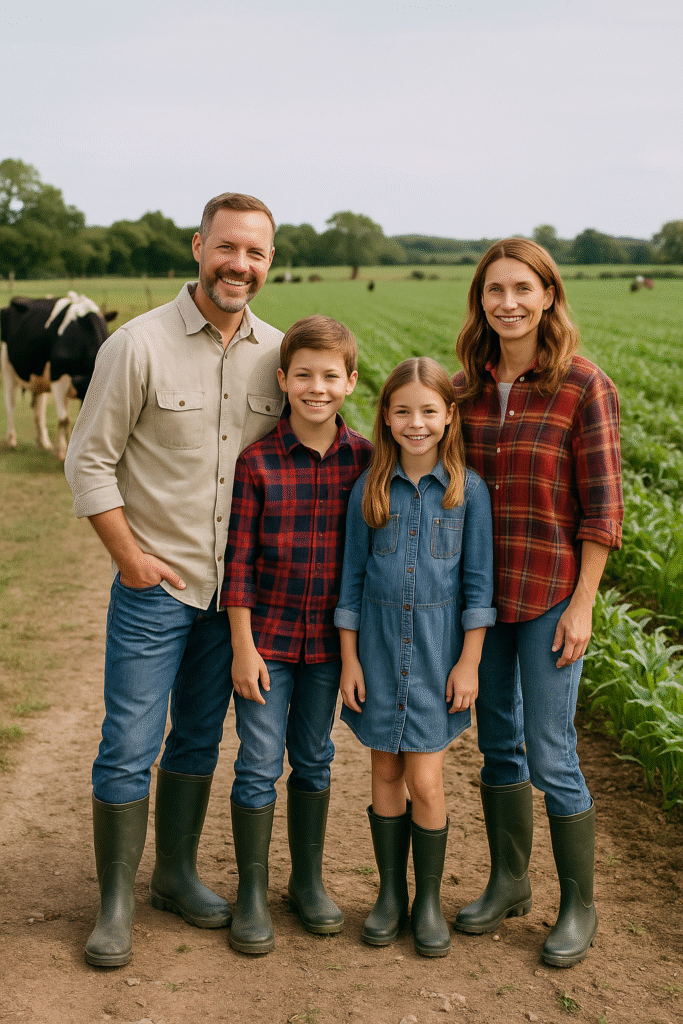
Gumboots: More Than Just Mud Boots
Whether you’ve grown up on the land or only visited a farm once, you’ve probably seen a pair of gumboots sitting by the back door. But why do farmers need gumboots every day? For many farmers like myself, gumboots aren’t just something to slip on when it’s wet — they’re a daily essential, walking in them for hours if needed.
1. Why Farmers Need Gumboots for Every Farm Job
Gumboots — or “wellies” in some parts of the world — are waterproof boots, usually made of rubber or PVC, that slip over the foot and lower leg. On a farm, they do a lot more than just keep your feet dry.
Here’s what gumboots really offer:
- Protection from mud, muck, and manure
- Barrier against bacteria and farm chemicals
- Traction on slippery or uneven ground
- Warmth in winter and a quick rinse-off in summer
- A no-fuss, no-laces solution for busy days
Farmers grab gumboots like a builder grabs a hammer — they’re a tool of the trade.
2. Gumboots in Dairy Farming: Sloshing Through the Day
On a dairy farm, gumboots are worn daily — often for hours on end.
Why do farmers need gumboots here?.
Because the dairy shed is wet, messy, and full of hazards. Between hosing down the concrete, walking through cow manure, and standing beside big animals with heavy hooves, gumboots play a huge role in:
- Hygiene: Easy to rinse, which helps control disease and bacteria.
- Safety: Thick soles protect feet from being stepped on or slipping.
- Comfort: Many dairy farmers go for boots with cushioned insoles and arch support.
In fact, many farmers have two pairs: one for the shed, and one for everything else.
3. Cropping Farms: Dusty Fields and Muddy Days
When people think of cropping, they picture dry paddocks and tractors. But ask any cropping farmer, and they’ll tell you: it’s not always that clean.
Gumboots earn their place during:
- Planting season: When irrigated fields can be soft and sticky.
- Early mornings: With dew-heavy grass or soil.
- After rain: Checking crops or clearing drains requires waterproof footing.
Unlike dairy boots, cropping gumboots don’t always need to be as heavy. Farmers here often opt for lighter boots that still keep their feet clean when walking the rows.
And when harvest comes? They’re handy for wet storage sheds, machinery wash-downs, and those surprise showers that turn a paddock into a swamp. And that is why even crop farmers need gumboots.
4. Pig Farming: Clean Boots, Healthy Herd
Pig farming has its own set of challenges — and gumboots are part of keeping things safe and sanitary.
Wy do pig farmers definitely need gumboots
- Biosecurity: Pigs are vulnerable to disease, so it’s important boots can be disinfected or switched between sheds.
- Ease of cleaning: Smooth-surfaced boots make hose-downs quick.
- Protection: Pigs are curious and sometimes pushy — thick boots protect from nips and muddy pen floors.
In pig farming, it’s not uncommon to have a boot wash station at every entry point. Gumboots aren’t just for comfort — they’re part of a strict health protocol.
5. Horticulture: From Veggie Beds to Orchards
In market gardens, greenhouses, and orchards, gumboots are just as important — but for different reasons.
Why horticulturalists love them:
- Soil protection: Keeps dirt out of socks and shoes when kneeling or bending.
- Irrigation: Walking through watered rows without ruining your footwear.
- Seasonal shifts: Spring rains, autumn puddles, and muddy greenhouse floors all call for waterproof gear.
Horticulture often involves lots of bending and moving, so lighter, flexible gumboots are often preferred — especially those that are comfortable to wear for hours while planting, pruning, or harvesting.
6. Not Just for Farmers: Lifestyle Blocks and Visitors
You don’t have to be a full-time farmer to appreciate a good pair of gumboots.
On lifestyle blocks or hobby farms, gumboots come in handy for:
- Feeding chickens
- Clearing drains
- Gardening in soggy soil
- Walking the paddocks after rain
And for urban visitors? Gumboots are the perfect footwear when helping out on a mate’s farm, going to a country show, or heading to a field day. No one wants to scrub sneakers after a stroll through a sheep paddock!
7. Weather and Seasons: When Gumboots Really Matter
While gumboots can be worn year-round, some times of year really highlight their importance.
- Winter: Mud, cold puddles, and frozen mornings make them a must.
- Spring: Rain and planting season bring wet soil and slippery yards.
- Autumn: Harvest time and stormy weather call for solid footing.
- Summer: Even in the dry, irrigation systems and animal troughs make them useful.
Some farmers even swap pairs through the year — a lighter one for summer, a thicker insulated pair for winter.
8. The Culture of Gumboots: A Kiwi Classic
In New Zealand and Australia, gumboots aren’t just practical — they’re a bit of an icon. Think of the famous Taihape Gumboot Throwing Festival, or all the kids lined up outside kindy in their colorful puddle stompers.
They’re so much a part of rural life that you’ll find them:
- Lined up at every farm back door
- In utes and tractors, ready for action
- Hanging by gates, garden sheds, and dairy platforms
Whether you call them gumboots, wellies, or rubber boots — they’re a symbol of life on the land.
Conclusion: No Farm is Complete Without Gumboots
From dairy sheds to veggie patches, cropping fields to pig pens, farmers need gumboots to walk through all the messy and also beautiful parts of farming life. They’re simple, strong, and endlessly useful.
So next time you visit a farm or head out to feed the chooks, spare a thought (and maybe a smile) for the humble gumboot — the quiet hero of the farmyard.
